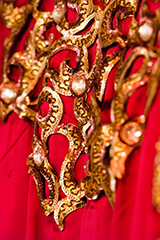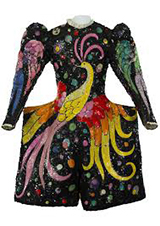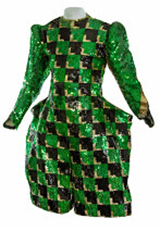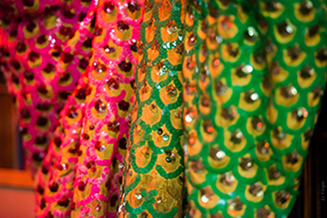by Pascal Jacob
In the early 1920s, Henri Vicaire, an artisan stone cutter and importer of Bohemian crystal, was the official supplier to a number of Parisian couturiers, always keen to acquire embroidery and sequins, which were very fashionable at the time.
The crisis caused by the Wall Street Crash in 1929 undermined the world of haute couture and his son Charles, who set up on his own with his wife Simone, created evening dresses and small embroidered bags. It was Simone’s idea to turn to the world of the theatre. The quality of their work was such that Henri Varna, the then director of the Casino de Paris, taught Simone Vicaire the secrets of assembling music hall costumes. In the 1930s, the Maison Vicaire began creating costumes for the circus. It was Jérôme Medrano who offered them their first contracts and most of the major circuses soon followed suit. With around thirty employees, the Atelier Vicaire remained a family business. Simone Vicaire, assisted by her two sons Roger and Gérard, gained the trust of the great circus families, such as the Bougliones, the Knies, the Krones and the Tognis, as well as some of the finest stages in Europe and America, such as the Bal Tabarin, the Folies-Bergère, the Lido, the Moulin Rouge, not to mention Holiday on Ice, Ringling Bros. and Barnum & Bailey and, of course, huge stars of screen and music hall, from Mistinguett to Josephine Baker, Liza Minelli and Jean-Paul Belmondo.
But beyond the elegant dresses, extravagant stage outfits and sumptuously embroidered velvet curtains, Gérard Vicaire’s pride and secret passion was clown costumes. Since the first order made for Despard in 1931, a green and red chequered costume with a sequined bib, more than four hundred sequined costumes, coats and boleros, encrusted or embroidered with boundless creativity, were produced on his workshop tables. Owning your “own” Vicaire has always been the symbol of belonging to a small, very closed but infinitely desirable club.
Gérard Vicaire made hundreds of costumes as well as designing countless others, drawing his inspiration from the geometry of forms, nature and games, creating, with costume after costume, a visual repertoire of great richness. Some abstract patterns follow the lines of the body and transform it into a tableau vivant; others, completely figurative, tell stories in which animals from the jungle, savannah or ice fields happily rub shoulders, or in which dice and playing cards seem ready to be rolled across the green carpet of a coat fashioned from deep velvet. Some are sequined in their entirety, while others boast an elegant embroidery that simply emphasises the accuracy of the cut and precision of the drape. Dreaming up, ordering and owning a Vicaire has long been a way of marking the passing of time in the history of clowning, before coming to symbolise, through the sparkle of thousands of sequins, that of the circus itself.
Gérard Vicaire died on 12 November 2018.






